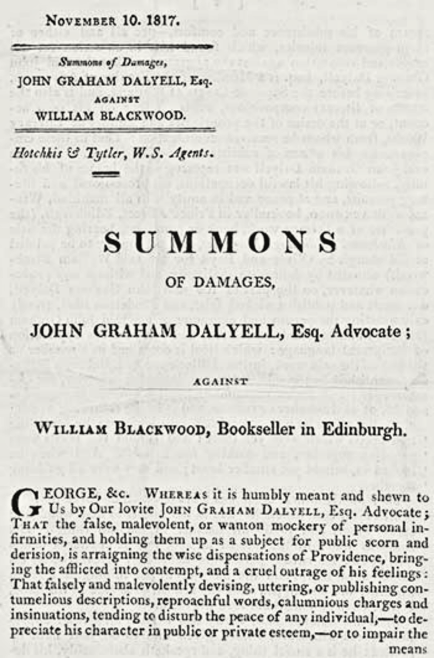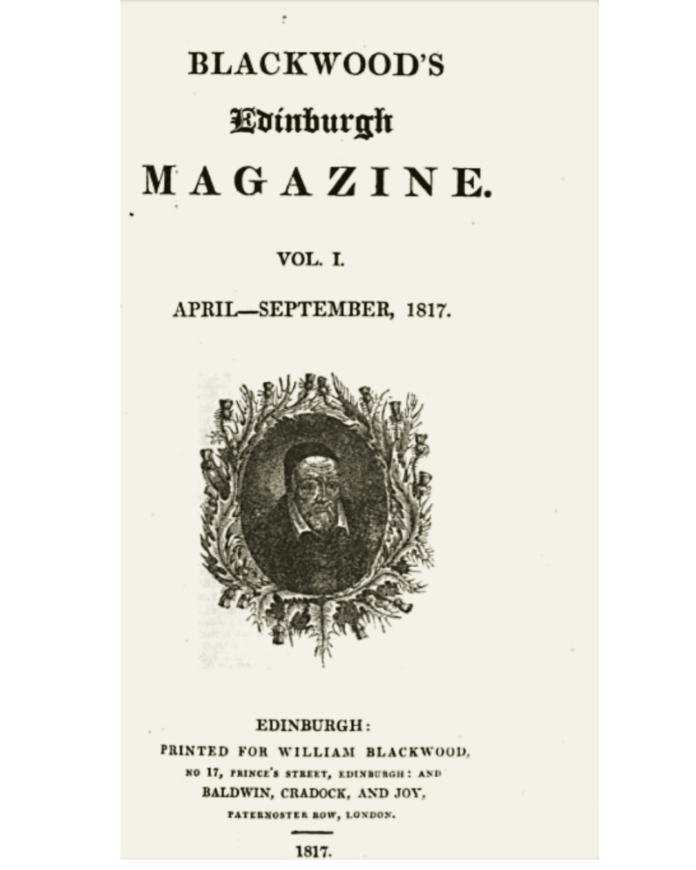Edinburgh Magazine was launched by Firefly Magazines in January 2020, right before the outbreak of COVID-19. As the fifth local magazine under Firefly, it joined other successful local magazines like Newcastle, Durham, Sunderland, and Consett. Edinburgh Magazine aimed to provide a platform for the city’s residents to showcase their talents, businesses, and community initiatives. It covers local events, cultural happenings, and business news. The magazine allowed the city to be showcased to a wider audience and provided a new source of information and entertainment for its residents.
This article will focus on the first Edinburgh Magazine, Blackwood’s Edinburgh Magazine, which was established well before the 2020 global pandemic and the launch of the current Edinburgh Magazine by Firefly Magazines. Despite its age, Blackwood’s still holds a significant place in literature and publishing history and its impact is still felt today. The article will examine the origin and evolution of Blackwood’s, exploring its controversial style, popularity, and lasting influence on writers and publishers.
Blackwood’s Edinburgh Magazine, also known as “Blackwood’s,” was established in 1817 as a literary and political periodical in Edinburgh, Scotland. It gained notoriety for its satirical and controversial content, which often dealt with politics, religion, and social issues of the time. Despite facing censorship and criticism, the magazine established a strong reputation and became a staple in 19th-century British literary and intellectual circles. Its legacy lives on as a landmark publication in the history of journalism and literature.
In 1817, Blackwood’s Edinburgh Magazine underwent a major transformation and was relaunched as simply “Blackwood’s Magazine.” This change reflected a shift in focus from Edinburgh-centric content to a more broad-ranging perspective that sought to appeal to a wider audience. This relaunch also marked a change in editorial leadership, as William Blackwood took over as editor and began to shape the magazine in his own image.


Blackwood’s editorship was characterized by a focus on literary quality and a commitment to presenting a wide range of perspectives. He sought out contributions from some of the most talented writers of the day, including Sir Walter Scott, John Wilson, and Thomas De Quincey. Under Blackwood’s leadership, the magazine published a mix of fiction, poetry, and critical essays that covered a wide range of topics, from politics and philosophy to travel and adventure.
Blackwood’s editorship was also notable for its willingness to tackle controversial subjects. The magazine was known for its outspoken political views and for taking bold positions on social and political issues. Blackwood was unafraid to use the magazine as a platform to express his own opinions, and his editorial stance helped to shape the public discourse of the day.
The relaunch of Blackwood’s Edinburgh Magazine as Blackwood’s Magazine marked a turning point in the magazine’s history, and set it on a path towards becoming one of the most influential literary publications of the 19th century. Blackwood’s editorship laid the foundation for a new era of editorial leadership and set the tone for the magazine’s continued success.
William Blackwood was a Scottish publisher and founder of the eponymous publishing house, William Blackwood and Sons. He was born in Edinburgh in 1776 and began his publishing career by establishing the “Edinburgh Monthly Magazine” in 1817. The magazine was later renamed to “Blackwood’s Edinburgh Magazine,” which became one of the most influential literary and political magazines of its time.
Blackwood was known for his keen eye for talent, publishing works by many famous writers, including John Keats, Walter Scott, and Samuel Taylor Coleridge. He also had a strong interest in politics, which is reflected in the political and satirical content of the magazine.
Throughout his career, Blackwood was a respected figure in the literary and publishing world, and his legacy continues to this day. His publishing house, William Blackwood and Sons, is still in operation and has published many notable works of fiction, non-fiction, and poetry.
William Blackwood was a pioneering publisher and entrepreneur, who made a lasting impact on the literary and political landscape of Scotland and the UK. His vision and dedication to publishing quality works of literature and journalism helped establish the “Blackwood’s Edinburgh Magazine” as a leading publication of its time.
Blackwood’s Edinburgh Magazine was founded as a response to the highly influential Edinburgh Review. The Edinburgh Review, established in 1802, was a Whig-leaning publication that aimed to critique and shape public opinion on literature, politics, and culture. Blackwood’s, on the other hand, was established with a conservative stance, with the goal of countering the liberal views presented in the Edinburgh Review. William Blackwood, the founder of the magazine, was a Scottish publisher with a strong conservative ideology. He believed in traditional values, such as the importance of the monarchy and the Church of Scotland, and wanted to establish a publication that would defend these values. It quickly established itself as a strong conservative voice, providing a counterbalance to the liberal views presented in the Edinburgh Review.
The magazine was known for its controversial style and its popularity due to contributions from notable writers such as John Wilson, John Gibson Lockhart, and William Maginn. The magazine’s content was often critical of contemporary political and social issues, and was not afraid to take a stance on controversial topics. This, along with its vibrant writing style, made it a popular choice for readers looking for an alternative to the more academic and serious-minded Edinburgh Review.
John Wilson, writing under the pen name “Christopher North”, was one of the most important contributors to Blackwood’s. His contributions, which often took the form of lengthy essays on various subjects, were known for their wit, humor, and caustic commentary. John Gibson Lockhart, the son-in-law of Sir Walter Scott, also wrote for the magazine, contributing both fiction and non-fiction works. William Maginn, a controversial Irish writer, was known for his satirical pieces that often poked fun at contemporary political and social issues.
The contributions of these writers helped to establish Blackwood’s as a popular and influential magazine in its own right, and helped to cement its reputation as a conservative voice in the literary world. Despite its controversial style and conservative credentials, the magazine remained popular for many years, and its legacy continues to influence modern-day writing and publishing.
The publication was known for works by radicals of British Romanticism and early feminist essays. The magazine was open to contributions from a diverse group of writers, including those with more radical views and perspectives. Some of the most notable works from this period were written by Percy Bysshe Shelley, Mary Wollstonecraft, and William Hazlitt. These works tackled topics such as the status of women in society and the relationship between the individual and the state.
Furthermore, the magazine was also known for publishing early feminist essays, which were groundbreaking for their time. The essays dealt with a range of topics, from the role of women in society to the importance of education and equal rights. The authors of these essays, many of whom were women, used the platform of Blackwood’s Edinburgh Magazine to voice their opinions and challenge traditional gender roles and expectations.
The publication of these works helped to establish Blackwood’s Edinburgh Magazine as a platform for the promotion of radical ideas and an important voice in the cultural and intellectual debates of the day. It also demonstrated the magazine’s commitment to promoting a diverse range of voices and perspectives, which was a key factor in its success and enduring popularity.
Works by William Wordsworth, a prominent poet of the Romantic era were supported by Blackwood. The magazine’s endorsement of Wordsworth’s poetry was in contrast to the criticism of the poet by other contemporary publications. Blackwood’s also published parodies of the Byronmania, the popular admiration of Lord Byron’s works, and was critical of the “Cockney School of Poetry,” a group of poets associated with the London metropolitan area who were seen as being too concerned with urban life and lacking in genuine emotion. These actions by the magazine demonstrated its commitment to promoting the works of traditional and rural-inspired poets, and its opposition to those seen as unconventional or urban-focused.
The London Magazine duel was a notable event in the literary world of early 19th century Britain. It was a highly publicized and controversial event that took place between two literary figures, John Scott and Jonathan Henry Christie, and was a result of an argument over the merits of the Romantic movement in poetry.
John Scott was the editor of the London Magazine, a rival publication to Blackwood’s Edinburgh Magazine, and was known for his support of the Romantic movement and its leading poets, such as William Wordsworth and Samuel Taylor Coleridge. Jonathan Henry Christie, on the other hand, was a critic of the Romantic movement and was associated with Blackwood’s Edinburgh Magazine, which had a reputation for its conservative views on literature.
The argument between Scott and Christie began as a literary disagreement in the pages of their respective magazines, but escalated into a personal insult. The two men eventually challenged each other to a duel, which took place on July 23, 1821, near London. Although both men were injured, Scott was the only one who died from his wounds.
The London Magazine duel was widely covered by the media of the time and was seen as a symbol of the intense passion and heated debates surrounding the Romantic movement in poetry. It also underscored the political and cultural divisions that existed in Britain during the early 19th century, with the conservative views of Blackwood’s Edinburgh Magazine standing in opposition to the radical views of the London Magazine and its editor, John Scott.
John Neal, an American writer and literary critic, was a prominent figure in the history of Edinburgh Magazine. In 1817, he started a series of articles in the magazine entitled “American Writers”. These articles were the first written history of American literature and aimed to introduce British audiences to the works of American writers. Neal’s series was well-received and helped to establish American literature as a distinct genre. He also used the articles to promote his own work and advocate for American independence. The “American Writers” series marked a turning point in the history of Edinburgh Magazine, demonstrating its willingness to engage with and promote works from beyond the British Isles. This open-mindedness towards literature from other countries would become a defining characteristic of the magazine in the years to come.
The 1840s marked a decline in popularity and circulation for Blackwood’s Edinburgh Magazine. Despite its long-standing reputation as a leading literary and political periodical, the magazine faced stiff competition from new and emerging publications. This was due in part to the increasing accessibility of print media, which enabled new and diverse voices to enter the market.
Additionally, the magazine’s conservative stance, which had once been a key factor in its success, became increasingly outdated as liberal and radical ideologies gained popularity. The publication of works by early feminists and other writers who challenged traditional gender roles and societal norms also contributed to its declining relevance.
Despite these challenges, the magazine continued to be published and still featured contributions from notable writers, including a number of poets and novelists who went on to become well-known figures in literary history. However, its influence and readership waned, and by the mid-19th century, Blackwood’s Edinburgh Magazine was no longer at the forefront of British literary and cultural life.
Edinburgh Magazine had a significant impact on later Victorian writers, particularly in the realm of fiction. Many writers, including Charles Dickens, were influenced by the magazine’s style and content. Dickens was a regular contributor to the magazine and his early works, such as “Sketches by Boz,” were first published in its pages. The Brontë sisters also read the magazine and were influenced by its themes of social justice and its focus on the lives of ordinary people.
Edgar Allan Poe, the famous American writer, was also influenced by Edinburgh Magazine. Poe was a fan of the magazine’s gothic and supernatural stories, and he was inspired by its style when writing his own works. In particular, Poe’s famous short story “The Black Cat” was heavily influenced by the gothic tales published in Edinburgh Magazine.
Sir Walter Scott reviewed Mary Shelley’s “Frankenstein” in “Blackwood’s Magazine”, and expressed his confusion over its subject matter, questioning its necessity. Despite publishing critical essays, the magazine was known for its personal attacks on public figures, which resulted in a number of lawsuits. In 1817, John Graham Dalyell sued William Blackwood for a “wicked, false, calumnious, and libellous publication”.


The summons of damages document, accusing Blackwood of damaging Dalyell’s reputation, is on display at the National Library of Scotland’s “Blackwood’s at 200” exhibition which ran from March 30th to July 2nd, 2017.
The magazine had a lasting impact on later Victorian writers, and its influence can still be seen in the works of these writers today. The magazine’s focus on social justice, its attention to the lives of ordinary people, and its gothic and supernatural stories all helped to shape the literary landscape of the Victorian era and beyond.
Blackwood’s Edinburgh Magazine continued to have a dedicated readership throughout the British Empire. Despite its decline in popularity and circulation in the 1840s, the magazine maintained a reputation for its conservative and controversial style. The magazine’s title page bore the image of the 16th-century Scottish historian and humanist George Buchanan, emphasizing the magazine’s Scottish roots and heritage.
Blackwood’s bookshop was located at 45 George Street in Edinburgh (take a look at this location now on Google Maps Street View), serving as a hub for literary and intellectual discussion. The shop was also a place for the dissemination of ideas and literature, as it sold not only its own magazine but also a variety of other books and periodicals.
William Blackwood, the founder and publisher of Blackwood’s Edinburgh Magazine, died in 1834 and was buried at the Old Calton Burial Ground in Edinburgh. His legacy lived on through the magazine and the bookshop, which continued to operate under the Blackwood family’s ownership until the 20th century.
It’s certainly true, Blackwood’s Edinburgh Magazine was a significant publication in the 19th century. It had a lasting impact on literature, politics, and intellectual discourse in Britain and the wider British Empire. Its legacy can be seen in the works of numerous Victorian writers such as Charles Dickens, the Brontë sisters, and Edgar Allan Poe. The magazine remains a testament to William Blackwood’s vision and ambition as a Scottish publisher. Its influence on the literary and intellectual world continues to be felt to this day.
Cultural References of Blackwood’s Edinburgh Magazine
Blackwood’s Edinburgh Magazine has made an impact not just in the literary world but also in popular culture. It has been referenced in various forms of media, including literature, film, and television.
In November 1838, Edgar Allan Poe published a short story entitled “How to Write a Blackwood Article” as a companion piece to “A Predicament.” This showed the influence that the magazine had on Poe and his writing.
In Dorothy Sayers’s detective novel “Five Red Herrings” (1931), the Scottish Procurator-Fiscal is mentioned as reading the latest issue of Blackwood’s Magazine to pass the time while they wait for the murderer to reveal themselves.
Vera Brittain lists “numerous copies of Blackwood’s Magazine” among her literary possessions in her memoir, “Testament of Youth” (1933), showing the significance of the magazine during her time as a V.A.D. nurse in Malta.
In George Orwell’s “Burmese Days” (1934), the main protagonist associates the magazine with mediocre crassness. He thinks about the other British at the European Club and wonders if they will ever think of anything new to say.
In the Doctor Who story “The Talons of Weng Chiang” (broadcast in 1977), Professor Litefoot is seen reading the February 1892 issue, showcasing the magazine’s enduring popularity even in the more modern era.
These cultural references demonstrate the lasting impact of Blackwood’s Edinburgh Magazine on popular culture and its continued relevance in the literary world.
You can read volume one of Blackwood’s Edinburgh Magazine first published in 1817 online here.


